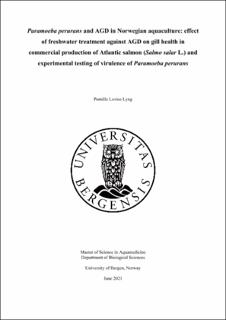| dc.description.abstract | Gill diseases are a major and increasing challenge with respect to fish health and welfare during the marine stage in Atlantic salmon farming. The causative agents for gill diseases are complex, and several pathogens are often present at the same time. Amoebic gill disease (AGD), caused by Paramoeba perurans, is strongly associated with gill diseases. To control and prevent development of the disease and mortality, freshwater treatment has shown to be the most effective method. Treatments and handling of the fish causes stressful situations affecting the fish negatively. How these stressful situations within the production affects the gills health and the associated microbiota is less known. The main amin of this study was to map how stress in relation to commercial production (freshwater treatment) affects the gill health of Atlantic salmon. The gills were studied, and pathogens (prevalence and density) were mapped before and after treatment in addition to fish that died during treatment. Histopathological changes compatible with AGD lesions were observed, but there were no significant changes between the groups. The prevalence and density of some pathogens were significantly reduced after treatment, including P. perurans, Ichthyobodo spp, Cand. S. salmonis and Cand. P. salmonis. Other pathogens, including PRV1, P. theridion, SGPV, PMCV and Cand. B. cysticola, increased or had no change of prevalence and density in the gill tissue. The mortality prior to and during the treatment were high, but significantly reduced for the treated group. These results suggests that gill health prior to treatment, and presence of viruses will affect the outcome of the treatment and the mortality rate. A complementary challenge experiment was conducted to test the possible effect of microbiota on the virulence of clonal cultures of Paramoeba perurans during an experimental challenge. Characterization of microbiota present in the culture media of P. perurans showed a large variation of bacteria species, dominated by Vibrio splendidus variants. Although P. perurans cultured in pure culture of V. splendidus grew as well as the amoeba in the original culture media, the clones where not able to establish infection on the gills. The results indicates that the clone’s loss of ability to induce AGD in salmon could be related to the change in microbiota in the amoebas culture media or microbiota present on the salmon gill during infection with amoeba. | |
